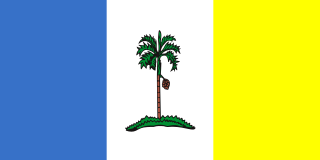
Penang is a Malaysian state located on the northwest coast of Peninsular Malaysia along the Strait of Malacca. It has two parts: Penang Island, where the capital city, George Town, is located, and Seberang Perai on the Malay Peninsula. These two halves are physically connected by the Penang Bridge and the Second Penang Bridge. The state shares borders with Kedah to the north and east, and Perak to the south.

The Tun Abdul Razak Complex, formerly the PenangUrban Centre, is a civic complex within the central business district of George Town in the Malaysian state of Penang. At the time of its completion in 1985, Komtar Tower, at 231.7 metres (760 ft), was the second tallest building in Asia and the tallest in Southeast Asia until 1986 when it was surpassed by One Raffles Place in Singapore. Other buildings in the complex include a hotel building, four shopping malls, an urban park, and a central transportation hub. The complex contains 1,420,000 square feet (132,000 m2) of office and retail space on a 27-acre (11 ha) superblock. It currently houses the administrative offices of the Penang state government and the chief minister of Penang.

Chung Thye PhinMSC, JP was a Chinese Malayan business magnate, planter, miner, bureaucrat, and philanthropist who served as the last Kapitan Cina of Perak and Malaya. He was reported to be the richest man in Penang.

Kapitan China Chung Keng Quee was the founder and administrator of modern Taiping in Perak, Malaysia. Appointed "Capitan China" by the British in 1877, he was a millionaire philanthropist and known as an innovator in the mining of tin. He was involved in many other industries including farming, pawnbroking and logging. He was respected by both Chinese and European communities in the early colonial settlement. His survival in the chaotic era owes much to his standing as leader of the Hai San, a Chinese secret society in British Malaya during the time of the Larut Wars (1862–73). a position he is said to have held till early 1884 although in all probability he continued to remain a leading member. The old fort at Teluk Batu was built by him to safeguard the mine that he opened there. He was a member of the Commission for the Pacification of Larut and sat as one of six members of the Advisory Perak State Council appointed by the British. Commenting on the role of the Perak Council, Richard James Wilkinson wrote,
"It is for the reader, in the light of subsequent events, to judge how far the Councillors were right or wrong, and to see for himself who really did the pioneer work of building up the prosperity of Perak. In the published accounts of British rule in Malaya, sufficient prominence has not always been given to the efforts of these early pioneers; the reaper, intent on his own work, is apt to forget the man who sowed. These Council Minutes are the record of the work of the sowers. A study of that record will show how much the State owes to Sir Hugh Low and to his fellow-Councillors, especially Raja Dris, Sir William Maxwell, and the Chinese towkays, Ah Kwi [Chung Keng Quee] and Ah Yam."
Swan & Maclaren Architects is a Singaporean architectural and industrial design firm. One of the oldest architectural firms in the country, it was formerly known as Swan & Maclaren and Swan & Lermit, and was one of the most prominent architectural firms in Singapore when it was a crown colony during the early 20th century. The firm has designed numerous iconic heritage buildings in Singapore as well as Malaysia.
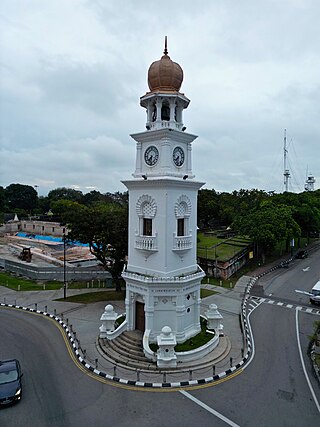
The Queen Victoria Memorial Clock Tower is an Moorish-style Jubilee clocktower within George Town in the Malaysian state of Penang. Located at the intersection of Light Street and Beach Street, it was built to commemorate the Diamond Jubilee of Queen Victoria in 1897. The tower is sixty feet to the centre of the clock, one foot for each year of Victoria's reign. A corner of the wall surrounding Fort Cornwallis is situated behind the tower. It was donated by Cheah Chen Eok, a local businessman, who provided $30,000 for the purpose, and was designed by Mr. Pierce, Municipal Engineer, Penang, and built by Messrs Barnett and Stark.
Perlis State Secretriat Building is Perlis's state secretariat building. It is situated on Jalan Hospital, Kangar.

The Hai San Society, which had its origins in Southern China, was a Penang-based Chinese secret society established around 1820 and in 1825 led by Low, Ah Chong and Hoh Akow, its titular head. At that time the society's headquarters was located at Beach Street.
Cheah Tek Soon was a 19th-century Penang businessman, and headman of the Hokkien in Penang, after whom Tek Soon Street was named. He was an active member of the Penang community and the bandstand that was erected near the Town Hall before the Japanese Occupation was his gift to the city.
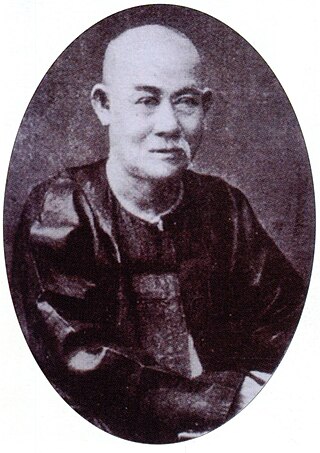
Foo Tye Sin was a Justice of the Peace and an influential community leader of 19th century. Penang born Foo Tye Sin, a British subject, was a Hakka tin miner who could trace his ancestry to the Yong Ting District, Ting Chou Prefecture, Fujian. He was educated at St. Xavier's Institution and the Penang Free School. Tye Sin Street (四条路), or Lebuh Tye Sin as it is now known as, is named after him.
Leong Sin Nam, alias Leong Sin, Leung Sin, Leong Sin Hee, was a Malaysian businessman. He migrated and settled in British Malaya in 1898. From humble beginnings, he worked hard to become a wealthy tin mine owner in Perak. He was a businessman, an active community leader and a philanthropist. He was a Chinese revolutionary with similar aspirations as Sun Yat-sen and a strong supporter of the Chinese war efforts during the Sino-Japanese war.

The Pinang Peranakan Mansion in George Town, Penang, Malaysia, is a museum dedicated to Penang's Peranakan heritage. The museum itself is housed within a distinctive green-hued mansion at Church Street, George Town, which once served as the residence and office of a 19th-century Chinese tycoon, Chung Keng Quee.

The Penang riots occurred on Penang Island, Malaysia, between 3 August and 12 August 1867 when it was a British Crown Colony. They began as a result of rising tensions between two Chinese secret societies, the Gee Hin and the Toh Peh Kong, who were traditional enemies and were triggered by an incident involving the throwing of a rambutan skin at a member of Toh Peh Kong by a Gee Hin member whilst calling him a thief, and became known as "the rambutan skin riots". Later, hundreds of members of each side took to the streets and fought pitched battles, many armed with muskets, and there was widespread arson directed particularly against homes and business of rival members.
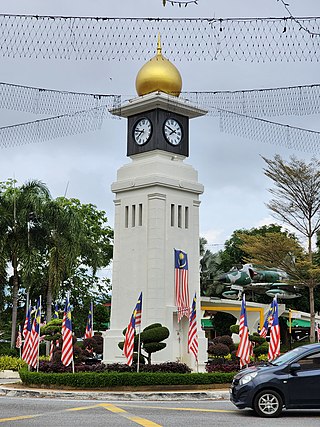
The Coronation Memorial clock tower is a clock tower situated in Kuala Kangsar, Perak, Malaysia.

Homestead is a mansion in George Town within the Malaysian state of Penang.

The Francis Light statue is a memorial to Captain Francis Light (1740–1794), the founder of the British colony of Penang in 1786. It is situated in the grounds of Fort Cornwallis, George Town, Penang, Malaysia.
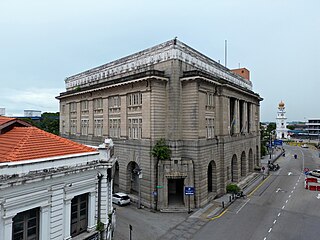
The Standard Chartered Bank building is a historical building in George Town within the Malaysian state of Penang. Completed in 1930, the office building, situated at Beach Street within George Town's Central Business District, was one of the tallest in the city at that time. It served as the Penang branch of Standard Chartered until 2017, after which the bank relocated to its new premise down the street. The building has since been reopened as Spaces Beach Street, one of IWG's coworking spaces in Malaysia.

Fort Cornwallis chapel is a Christian chapel situated inside Fort Cornwallis in George Town, within the Malaysian state of Penang.

Wesley Methodist Church Penang is a Methodist church in George Town within the Malaysian state of Penang. Built in 1912, it is situated at the junction of Burmah Road and Larut Road.
Ralph Henry Pinhorn OBE was a British educationalist and headmaster of the Penang Free School, the oldest English-medium school in Southeast Asia, from 1904 to 1925.
















